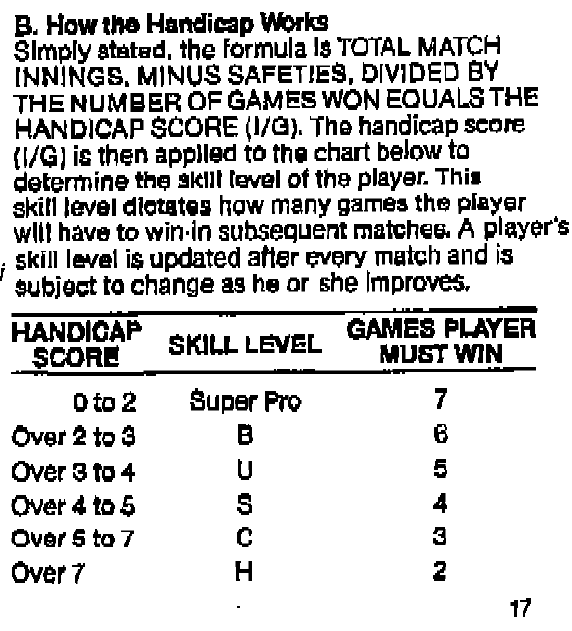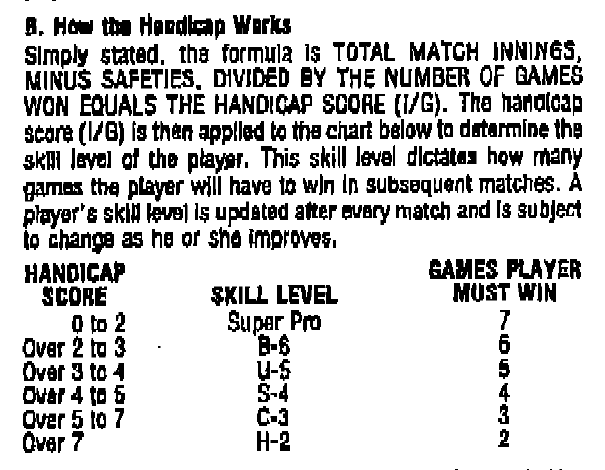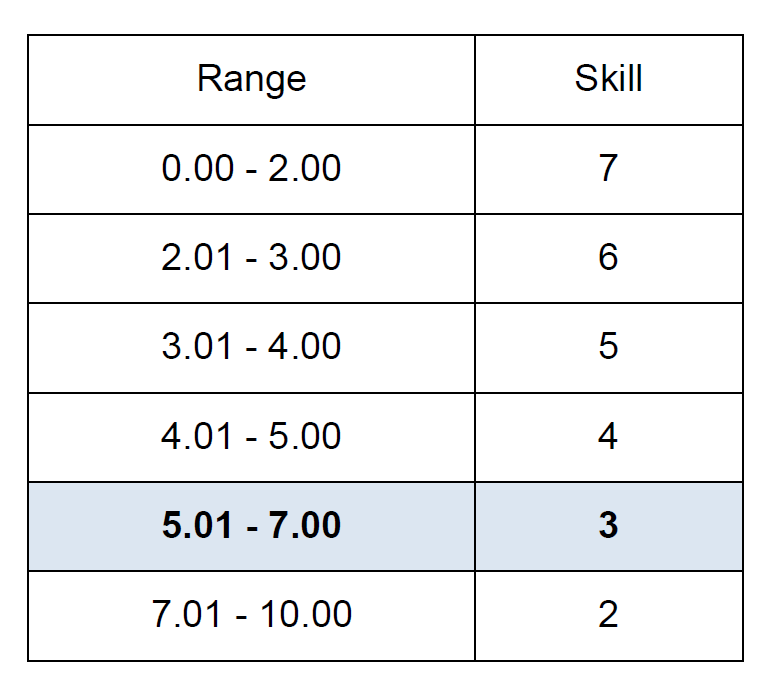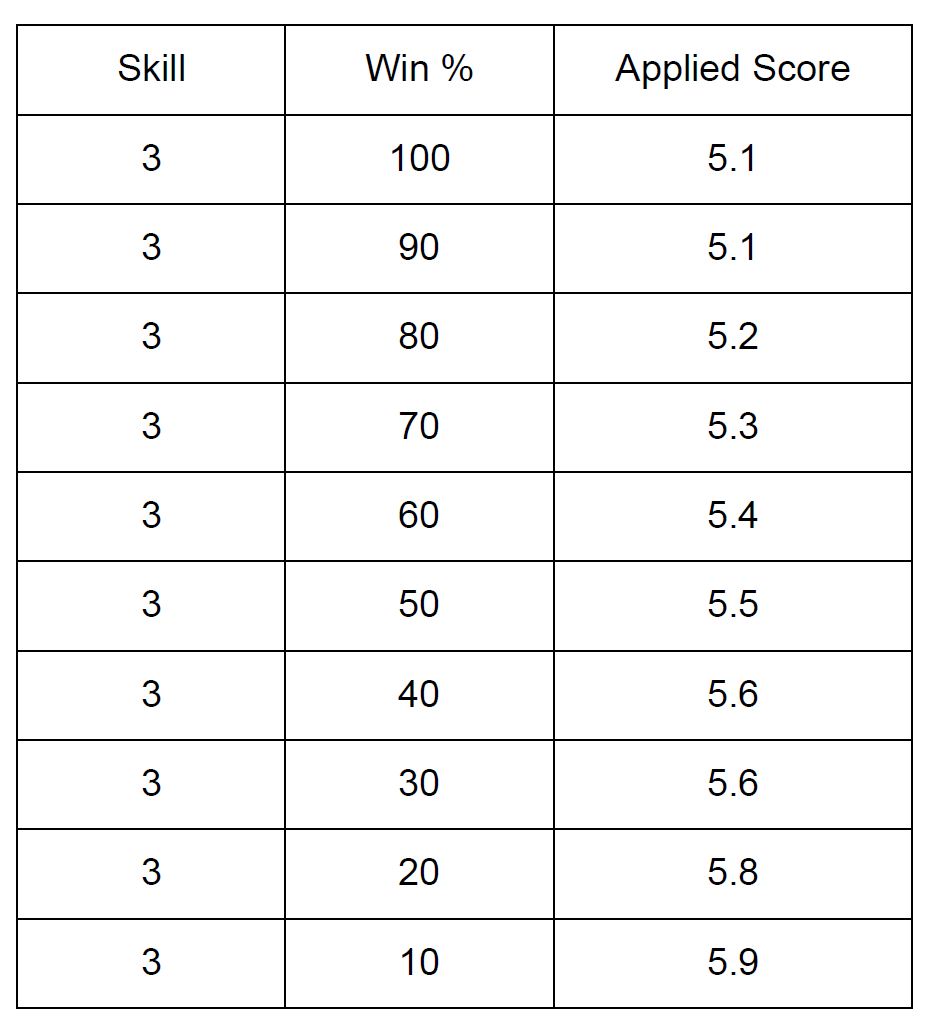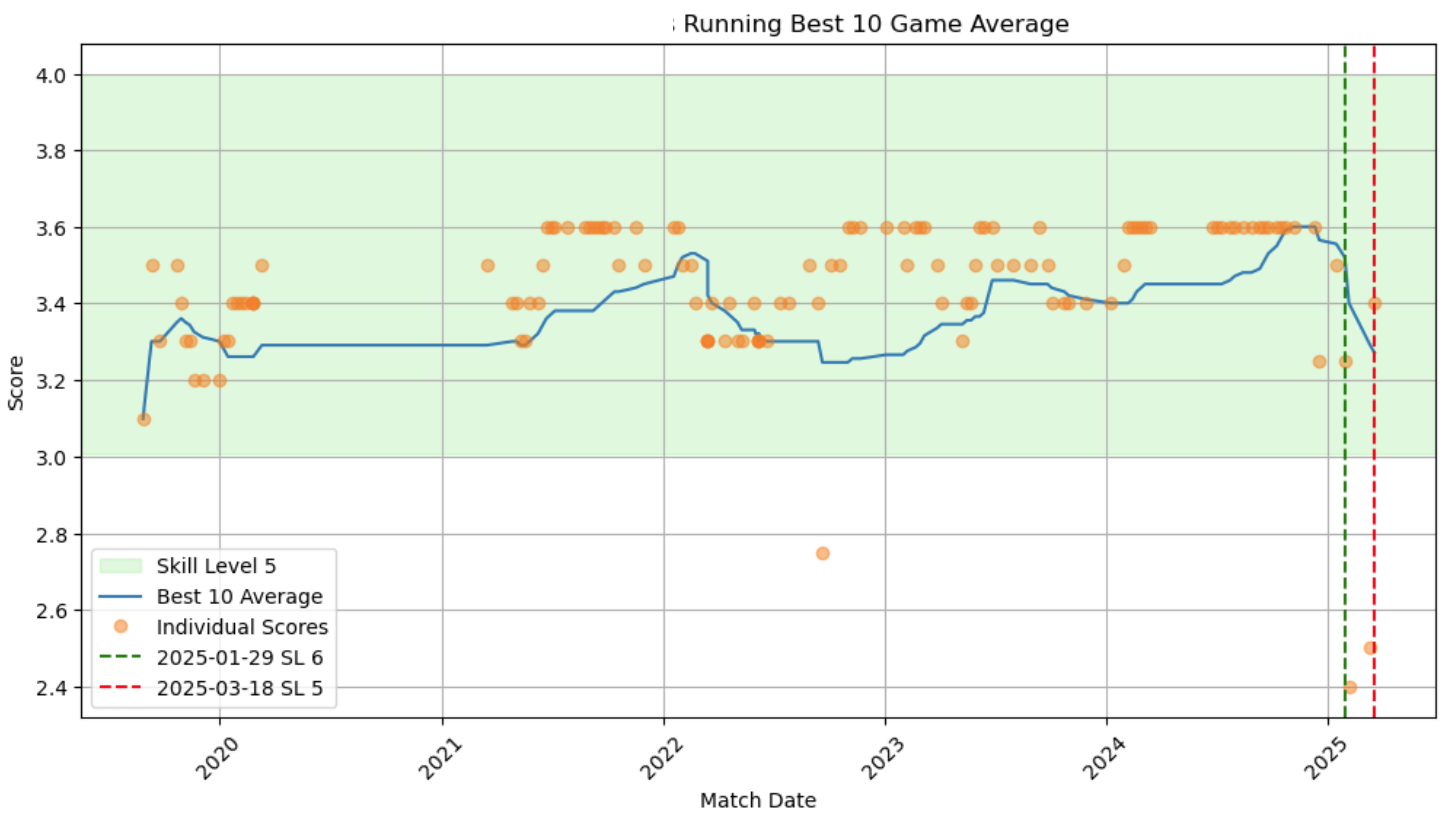If you play or have played in the APA, you’ve heard about the Equalizer®. It’s the APA’s handicapping system. It’s the subject of endless, normally fun, debate. Today I am going to demonstrate why the most widely referenced document about the Equalizer describes a system that is terrible. I’m going to pick it apart and show you why it just doesn’t work.
Note: I’m not saying that the system was never used, I’m just saying that it wouldn’t take long before people would realize the mythical version is terrible.
History of The Equalizer®
The APA was founded in 1979 by two professional pool players. The purpose of the league was and remains a place for amateur pool players to compete. The Equalizer® plays a vital role: level the playing field between different skill levels found amongst amateurs. Both the algorithm and the APA’s presentation of it have evolved over the years. In 1982, much of the algorithm was included in the player manual which was widely available. See the earliest version below. At this time, the league was known as the Busch league as can be seen in the skill levels.
There are several interesting details in this version of the manual:
The metric, (Innings - Safeties) ÷ Games Won is explicitly stated as the metric used to establish skill levels, shown in all-caps in the manual.
On page 18 of the manual, the APA discloses the best 5 of the last 10 matches are used to calculate skill.
Twelve innings is established as the maximum number of innings that can be included in the algorithm on page 18.
In this version of the rules, there was no default skill level as it exists today. A new player played a “best of 7” match against whoever they were first paired against. (Imagine that today with a couple of new players with no experience.)
1986 Manual
Fast-forward a couple of years and the manual was updated to the following:
In this version:
The scoring metric remains, but numeric skill levels have been added. These are the skill levels players are familiar with today, minus the Busch branding which will disappear completely in later versions.
Pages 20 and 21 explain that the “best 5 of last 10” technique is still used.
Page 21 states that the maximum innings is now capped at 10 instead of 12.
The initial match to establish skill level for a new player is now best 3 of 5 in this version of the manual on page 21. (Lol, wonder why this changed.)
The important takeaways from these versions of the manual are the usage of innings, safeties and wins, the existence of a maximum number of innings and the fact that the rules evolve year to year, at least to an extent.
The APA is still young at this point, so tweaks to the algorithm are to be expected.
2003 Internet Posting
By this point the APA stopped including details of the Equalizer® in the player manual. On October 30th 2003, someone posted something they claimed was the Equalizer® to a Google newsgroup called rec.sport.billiard. (I will refer to this post as “Barenada” from this point forward.) By December of that year, the APA made a DMCA claim to Google that the content infringed on copyrighted work and should be removed. The posting would eventually come down, but appear again in a post on azbiliards.com, and archived on Dr Dave’s website. Both of these are live as of this writing.
What’s interesting about this event is that the post the APA asked to have removed does not match the material they provided as proof. There are important differences:
The posting showed the algorithm using “Best 10 of last 20 innings”, which is not what the submitted player manuals showed.
Applied Scoring. Applied scoring has never been officially disclosed or confirmed by the APA. This is purported to be a technique to mitigate the effects of players purposely underperforming on purpose to keep skill levels artificially low. This is widely known as ‘sandbagging’.
The Barenada posting included an addendum with slightly different skill level targets. This addendum is not included in the azbilliards.com posting or Dr Dave’s website.
It’s interesting to note that the APA chose to use the DMCA to have the posting removed from Google, but either chose not to do this against azbilliards.com or Dr Dave, or they tried and failed. We have no way of knowing, but I can tell you there are no legal records of a court case. It is possible the APA has changed the algorithm around this time so keeping incorrect versions of the algorithm on the internet serves as convenient misinformation. (See why I said this is normally fun?)
Why it’s still not enough
While the technique described in the posting appears to be complete, there are a few items that aren’t defined well enough to use it as an algorithm. Notably these things:
Win percentage: This could mean lifetime win percentage, win percentage over the 20 matches included in the lookback period or win percentage over the 10 best matches. Lifetime is unlikely but either of the other are reasonable and possible.
The maximum allowed innings on a loss: It has been confirmed as 12 and 10 at different times. It’s not mentioned in the posting at all. This will have a large effect on the average calculated score when there are losses included in the best 10 matches.
How do you handle a lost match when you didn’t get any wins? The metric is undefined with a zero in the denominator. This happens frequently in practice.
Applied Scores: As Applied scores are based on win percentages to the nearest 10 (10, 20, 30, etc), if the best 20 matches are used, you’ll have to round. Does this indicate only the best 10 are used? Maybe, but it just doesn’t say.
You’re probably thinking “Well there are a few issues, but it looks like it would be pretty easy to try these and see what matches the data.”
That’s true, but there are other things about it that just don’t make sense.
Why it’s Terrible
Let’s look at an example of applied scoring for a moment. If you aren’t familiar, the idea of applied scoring is this:
If you win a game, but with more innings that the APA expects for a player with your skill and win percentage, they will replace your actual (innings - defense) ÷ wins with what they’d expect.
This idea could work, but it absolutely won’t with the numbers in the postings.
Let’s look at the numbers for a skill level 3: (according to the posts on azbilliards and Dr Dave.)
For a skill level 3 player, this is saying we would expect the average of their best 10 matches of the last 20 to average between 5 and 7 innings. Ignore for a moment whether these look realistic to you, because that doesn’t matter. Remember that, according to this, applied scores will replace wins with innings that are too high.
This table is used for applied scoring for a skill level 3.
You might already see the issue here. A player could have a 100 percent win percentage, average >5 innings per match, and never go to a skill level 4. To go up to a skill level 4, this player would have to play at least one match where this metric is less than 5 innings per win. (Consider for a moment how important marking defensive shots is and how poorly it’s typically done.)
From my experience, this is not realistic. Once someone approaches 100 percent wins in a season, they’re probably going to go up in skill. (7s excluded obviously) I’ve asked multiple experienced players about this. Everyone agrees, this isn’t a problem in 2025. This is a major clue that this algorithm isn’t correct and that’s a good thing.
Self-Reinforcement
There is a second, more subtle problem here. Let me use a hypothetical example. Let’s say you have a skill level 3 player who goes up to a 4 through a very lucky match. If that person wins one match as a 4, even playing more skill level 3 players, this will average in applied scores for a 4. Because you’re skill level X, we assume you play like and X even if you just got there and it was pretty lucky. In other words, once you go up, even one win makes it likely you’re staying, at least for a while. This is a self-reinforcing loop and not logical.
It’s important to note that there IS evidence that this is actually how the Equalizer works in 2025.
Empirical Evidence
Most importantly, this technique does not match reality.
Here is the algorithm, implemented as closely as possible. Yes I had to assume a few things as I stated before. (I tried several of the assumptions. This was the best fit.)
This is based on real data from a player who tracks his innings. This person quickly bounced from 5 to 6. Notice that the blue line NEVER approached the limit. Yes, there was a match or two at skill level 6 (hint), but no sustained performance there.
It’s pretty clear that the APA either doesn’t use this technique or more likely, has a layered approach to handle different scenarios and increase the complexity.
The Equalizer, from the APA’s perspective
The Equalizer provides value for league operators, which provides value to APA ownership. That’s the point. For those people who think the APA should scrap the Equalizer and use Fargo, that’s simply not possible. Fargo is competition. The value of the APA as a business is dependent on intellectual property and the Equalizer is that. They can also tweak it in any way they feel necessary. “It ain’t broke” from the APA’s perspective.
From the player perspective, the Equalizer isn’t perfect, but it’s good. (especially 9 ball) It’s also not bad enough that many people would quit over it. Again, from the APA’s perspective, that’s all that matters.
Personally, I find all the speculation and people trying to track it (see above lol) a lot of fun and a small part of what the APA is about for a small subset of players. The APA probably wouldn’t agree with that. We’re here to have fun and be entertained.
I don’t support trying to sandbag to control your skill level. If I think you’re doing that, I won’t play you in league. Ask my team captain in 🎱. I don’t hide it. I won’t pretend I would spot a highly skilled player doing it because I won’t. But given the opportunity, I will not pay my weekly fee to artificially raise my skill level and lower yours.
That said, if you want to do it, I don’t care. It’s part of the fun and strategy for you and this is a leisure activity. Personally, I want to drive my skill level as high as possible. If I ever make it to SL7, I’ll probably quit. Also, I have no interest in going to Las Vegas. My teammates hate that.
[One small but major aside/pet peeve: players will go to incredible and silly lengths to control/suppress their true skill level but won’t do the ONE LEGAL AND EASY THING: MARK DEFENSIVE SHOTS ON YOUR OPPONENTS! You push scoring down to the one or two people on the team willing to do it who either don’t recognize defense or simply don’t care. If a 6 isn’t trying to get shape, that’s defense. That’s not my opinion, watch the video.]
Lastly, it’s fairly easy for the APA to design a system that essentially impossible to replicate. Maybe they’ve already done that. Exponentially weighted moving averages and layered rules would be nearly impossible to mimic accurately. I would enjoy doing that work. Also, make sure it’s a difficult and manual to track the data used and you’re nearly there. (FWIW, I think the APA does okay here.)
If you’re from the APA and want to talk, reach out.




